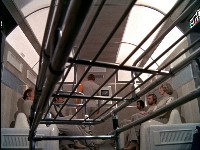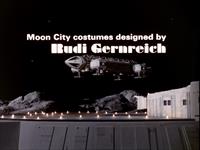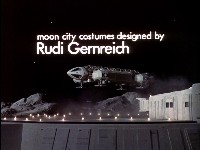![]() Year 1 - Episode 2
Year 1 - Episode 2 ![]()
| Screenplay by | Art Wallace Johnny Byrne |
| Directed by | Charles Crichton |
| Guest Artist | Richard Johnson |
| Original Title | Siren Planet | ||
| France/Canada | Question de vie ou de mort | Matter Of Life Or Death | 30 Oct 1976 |
| Germany | Rückkehr der Toten | Return Of The Dead | 26 Feb 1978 |
| Italy | Questione di vita o di morte | Matter Of Life Or Death | 21 Feb 1976 |
| Japan | Living dead in Space | 3 Jul 1977 | |
| Poland | Sprawa zycia i smierci | 5 Feb 1977 | |
| Portugal | Questão de Vida ou Morte | Question Of Life Or Death | 16 Oct 1976 |
| Spain | Cuestión de vida o muerte | Question of life and death | 18 Nov 1976 |
| Sweden | Antimateria | Antimatter | 12 Jun 1976 |
| South Africa | 'n Kwissie Van Lewe Of Dood | A Matter of Life and Death | 6 May 1977 |
| USA (Los Angeles) | 10 Jan 1976 | ||
| USA (New York) | 14 Dec 1975 | ||
| USA (San Francisco) | 29 Nov 1975 | ||
| UK (ATV) | 27 Nov 1975 | ||
| UK (LWT) | 29 Nov 1975 | ||
A man returns from the dead and promise of a new civilization on a planet resembling earth opens for those stranded on the runaway moon. But there is drama ahead. ITC summary
Int. Main Mission
Int. Command Office
Int. Care Unit
Int. Autopsy Room
Int. Helena's Quarters
Int. Victor's Quarters
Int. Alpha Corridor
Int. Travel Tube
Int. Eagle Pilot Section
Int. Eagle Passenger Section
Ext. Planet Surface
Main Mission is in the early layout with steps to the viewports (there is a slight change in Ring Around The Moon; the new layout is in Earthbound).
The Care Unit reappears in Ring Around The Moon
Helena's quarters are seen again (in a different form) in Dragon's Domain
0 fatalities.
Eagle 1 (Parks); 2 (landing party)
Terra Nova
When asked if Terra Nova is inhabited, Lee Russell answers "No. Yes. Not in the way you think." Which may mean the planet is inhabited, but the life forms are not recognisable.

During the in-show credits we see the medical crew in the travel unit moving to the launch pad. The gurney has no mattress (the director shoots the scene through the frame).
Matter Of Life and Death strongly echoes Stanislaw Lem's 1961 book Solaris (English translation 1970, filmed by Andrei Tarkovsky in 1972; the 1997 film Event Horizon also borrows elements). Terra Nova is like Solaris, a remote planet able to recreate spirits from the past. In both, a facsimile of the main character's dead spouse is created (in the filmed episode he is the real husband of Helena, but in the Siren Planet script, like Solaris, he is merely an image). Like the Siren Planet script, the book's end includes a reunion with an estranged father (here Koenig's father). The themes are similar; the difficulty of communication with a truly alien form, the limits of human comprehension. "We're a long way from home. And we're going to have to start thinking differently if we're to come to terms with space."
While the book and film delve into memory and ideas of self, the Space 1999 treatment is much less subtle. Siren Planet plays as an adventure, with the aliens tricking the Alphans from the planet, while Byrne's script is a science fiction mystery as the physical form of Lee is too weak and inarticulate to explain their situation.
Structurally the episode is flawed, with much disorienting and incoherent movement between rooms to establish minor plot points. Furthermore it is overly vague; why doesn't Lee just say "The planet is antimatter"? Why are Helena or the autopsy doctors electrocuted? Act 4 improves immensely, establishing idyllic pastoral scenes and then a rapid disintegration into chaos. The resolution, winding back time to before the chaos, is unsatisfying (War Games has a similar "it was all a dream" ending, but is better done).
Koenig's concern and caution is well played (overt jealousy would have been a mistake). Helena admits she is just "numb"- although there are some hints of confusion and distraction, her blankness is uninvolving and uninteresting, wasting the emotional opportunity of the plot.
Direction and cinematography especially noteworthy; unusual camera angles and wide, expansive panoramas are characteristic of Charles Crichton.


Contents copyright Martin Willey